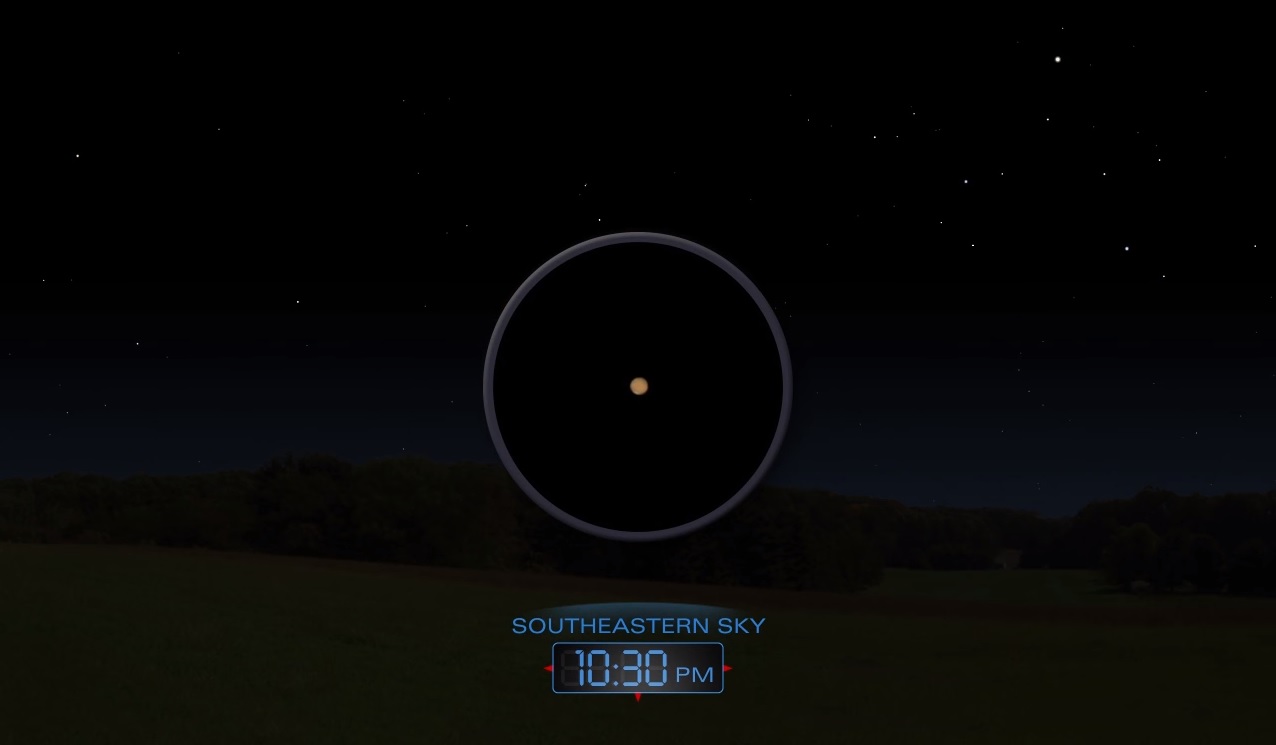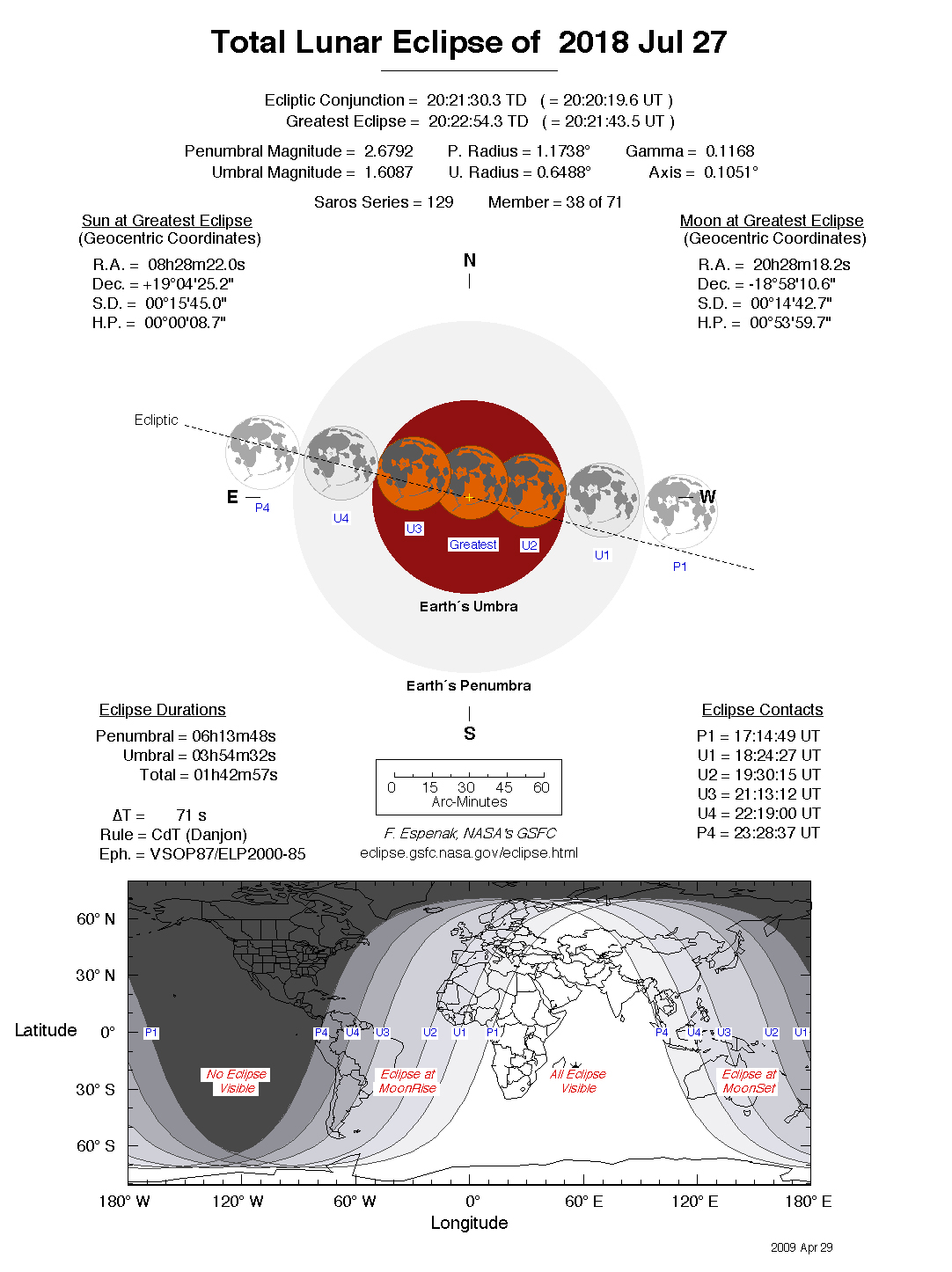Mars Is the Closest to Earth Since 2003 This Month (There's a Long Blood Moon Eclipse, Too)!
While you're getting ready to celebrate Independence Day with red, white and blue, prepare to see a lot of red in the sky in July. Mars will be at its brightest since 2003, and some skywatchers will be treated to a lengthy lunar eclipse as well.
The Red Planet is just about to reach the part of its orbit called opposition, where it is exactly opposite the sun in Earth's sky. This year, it will also herald Earth's closest view of Mars in 15 years. Earth and Mars orbit the sun at different distances. Because Earth is closer to the sun, it orbits faster than Mars. Once every two years (or thereabouts), the sun, Earth and Mars create a straight line with respect to each other — the opposition. [Mars Opposition 2018: What It Is & When to See It]
Opposition this year will happen on July 27, with the closest approach of Mars on 3:50 a.m. EDT (0750 GMT) on July 31. Mars will be bright in the sky — its brightest since 2003, when it came to its closest distance to Earth in nearly 60,000 years. In 2003, Mars was about 34.7 million miles (56 million kilometers) from Earth, according to NASA. This time, Mars will be 35.8 million miles (57.6 million km) away and will be 10 times brighter than usual.

You can currently find Mars in the mid-to-late-evening southeast sky in the constellation Capricornus, according to EarthSky.org. It will be at its brightest between July 21 and Aug. 3. In addition, the sun will start setting earlier around that time, making it easier to see the planet higher in the sky.
While Mars will look much brighter than usual, don't believe the hoax saying that Mars will be as big as the full moon. That's been circulating the internet since 2003, and it's just as false now as it was then. In reality, Mars will be only 24.3 arc seconds wide from Earth's perspective and will still appear as a bright, star-like object. The moon will appear 75 times larger, at 1,800 arc seconds, by comparison.
Blood moon
The other red world in the sky will be the moon, although it will turn red for only a couple of hours. On the same day Mars reaches opposition, the moon will go through the longest total lunar eclipse of the 21st century.
On July 27, observers in Africa, the Middle East, southern Asia and the Indian Ocean will see a total eclipse lasting an incredible 1 hour and 43 minutes. (Observers in North America, who will still be in daylight at that time, will need to watch the show on webcasts.) Including the partial phases of the eclipse, the moon will be in the Earth's shadow for nearly 4 hours. [Blood Moon 2018: Longest Total Lunar Eclipse of Century Occurs July 27]
Breaking space news, the latest updates on rocket launches, skywatching events and more!
Lunar eclipses happen when the moon passes into Earth's shadow, directly opposite the sun. Unlike solar eclipses, lunar eclipses are totally safe to view. You need no special equipment — only your own eyes. Lunar eclipses can be either a total or partial eclipse. During a partial eclipse, the moon has a black shadow on it that appears to take a "bite" out of its face.

But if the moon moves completely into the deepest part of Earth's shadow, known as the umbra, the moon turns red instead of going completely black. The red comes from some of the sunlight going through Earth's atmosphere. The sunlight bends and falls onto the moon's surface. (The air of Earth also scatters more shorter-wavelength light — think of colors such as blue or green — which leaves behind red at the longer-wavelength end of the spectrum.)
The time of greatest eclipse will be 4:21 p.m. EDT (2021 GMT) on July 27, according to EarthSky.org. The total eclipse will last from 3:30 p.m. to 5:13 p.m. EDT (1930 to 2113 GMT). If you can't see this eclipse, however, other opportunities will come up in a few months.
The next total lunar eclipse visible from North America will occur on Jan. 21, 2019, favoring viewers on the West Coast. The total phase will last about 1 hour and 2 minutes. Later that year, on July 16, there will be a partial eclipse. July 16, 2019, also happens to be the 50th anniversary of the launch of the first moon landing mission, Apollo 11.
Follow us @Spacedotcom, Facebook and Google+. Original article on Space.com.
Join our Space Forums to keep talking space on the latest missions, night sky and more! And if you have a news tip, correction or comment, let us know at: community@space.com.

Elizabeth Howell (she/her), Ph.D., was a staff writer in the spaceflight channel between 2022 and 2024 specializing in Canadian space news. She was contributing writer for Space.com for 10 years from 2012 to 2024. Elizabeth's reporting includes multiple exclusives with the White House, leading world coverage about a lost-and-found space tomato on the International Space Station, witnessing five human spaceflight launches on two continents, flying parabolic, working inside a spacesuit, and participating in a simulated Mars mission. Her latest book, "Why Am I Taller?" (ECW Press, 2022) is co-written with astronaut Dave Williams.
